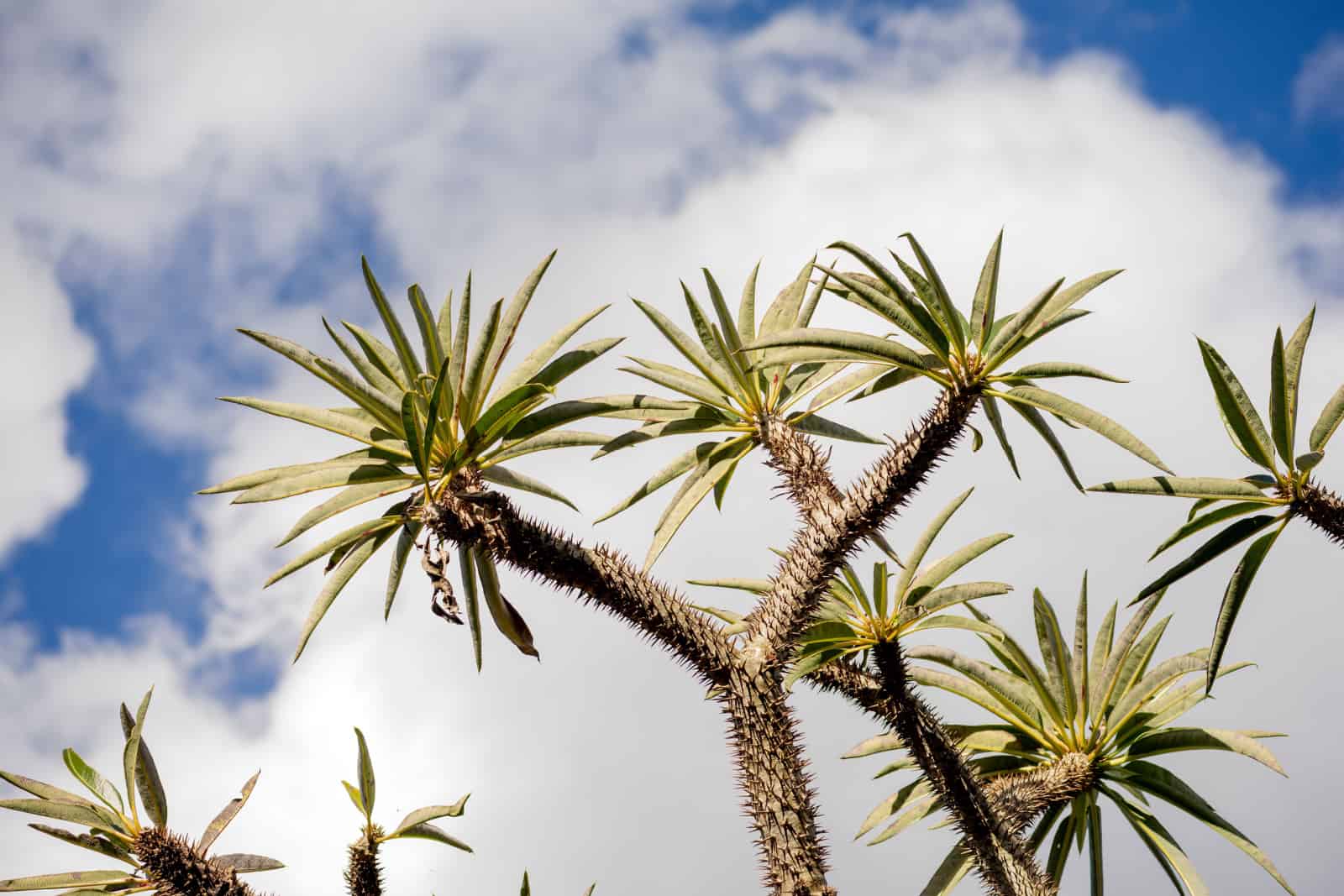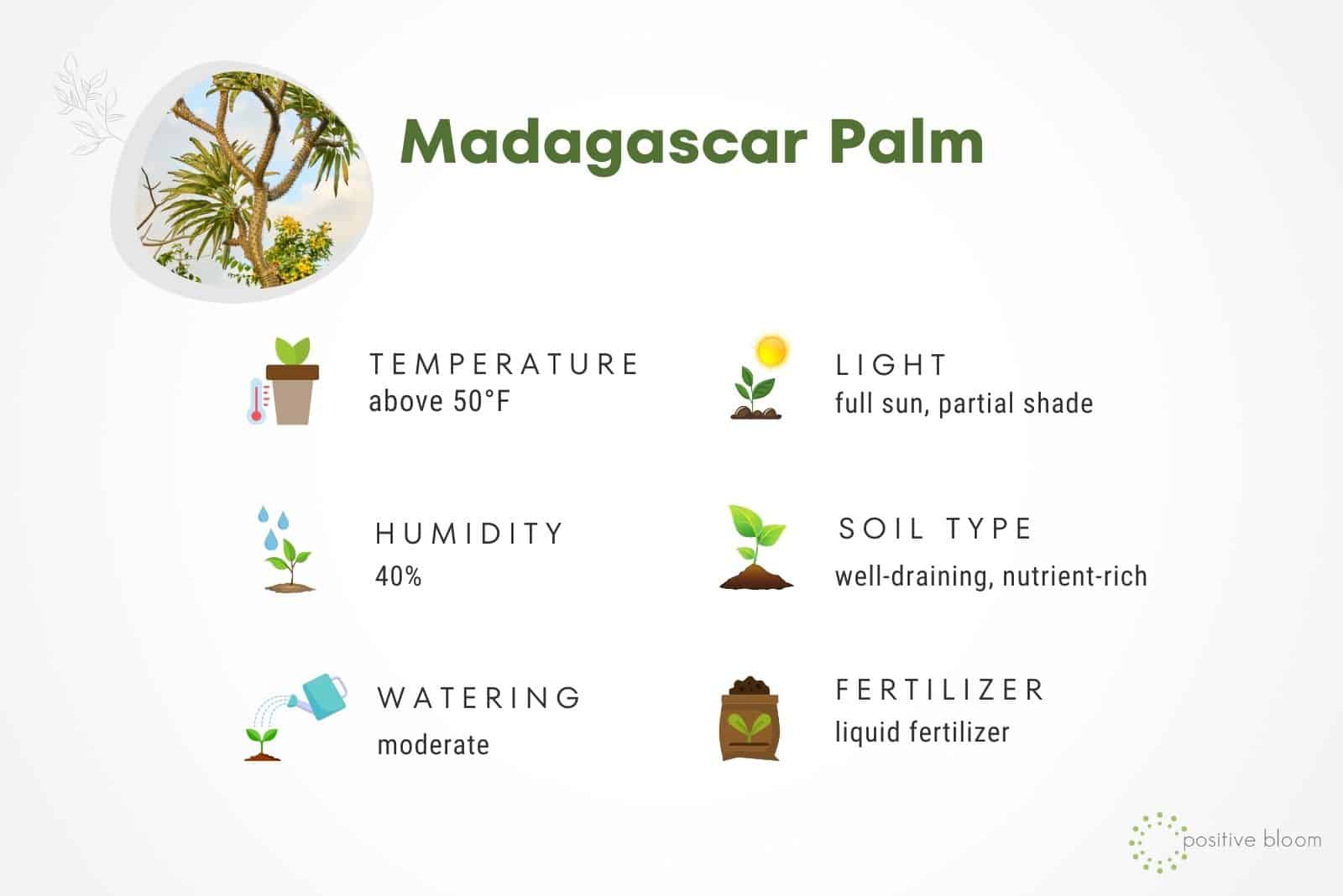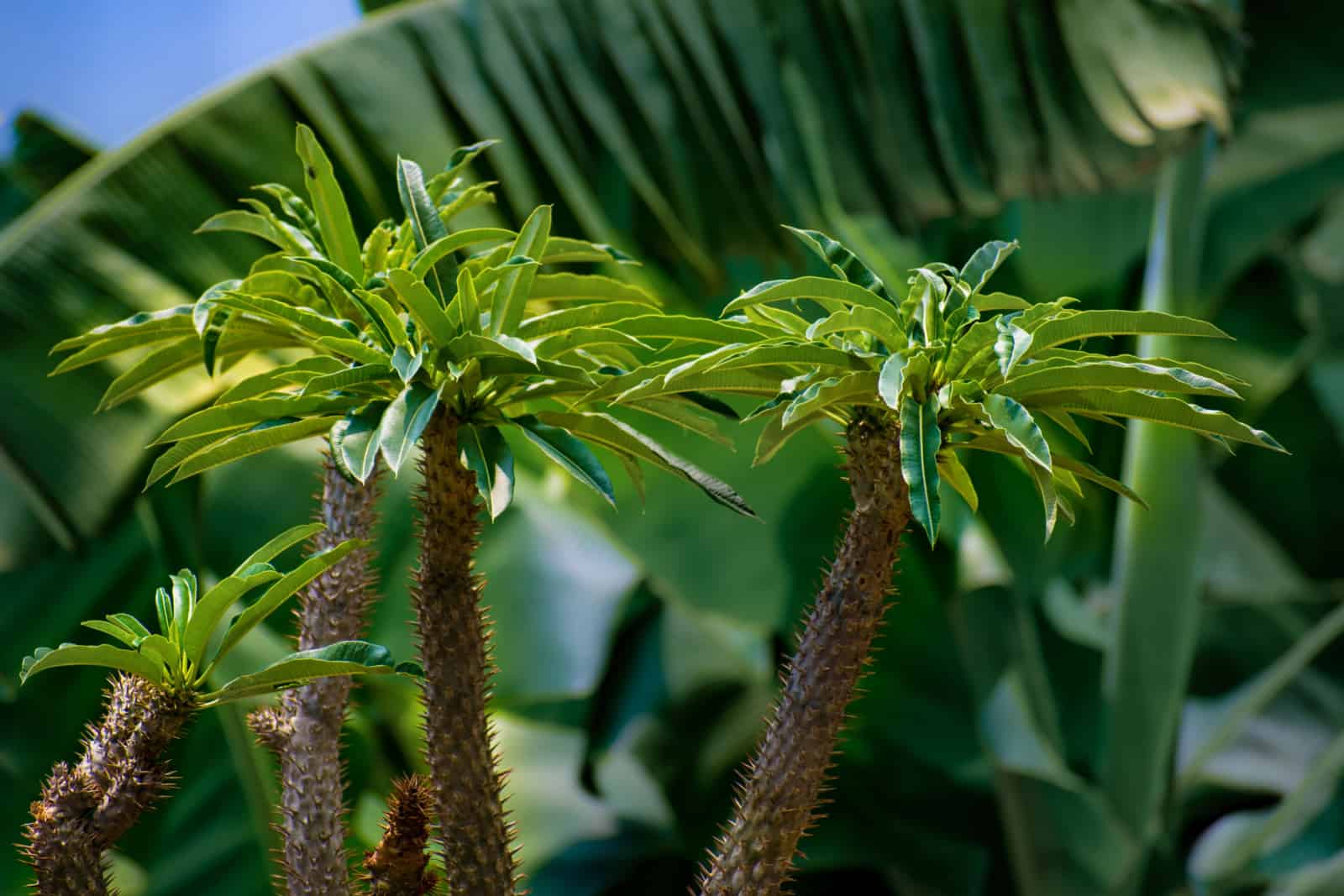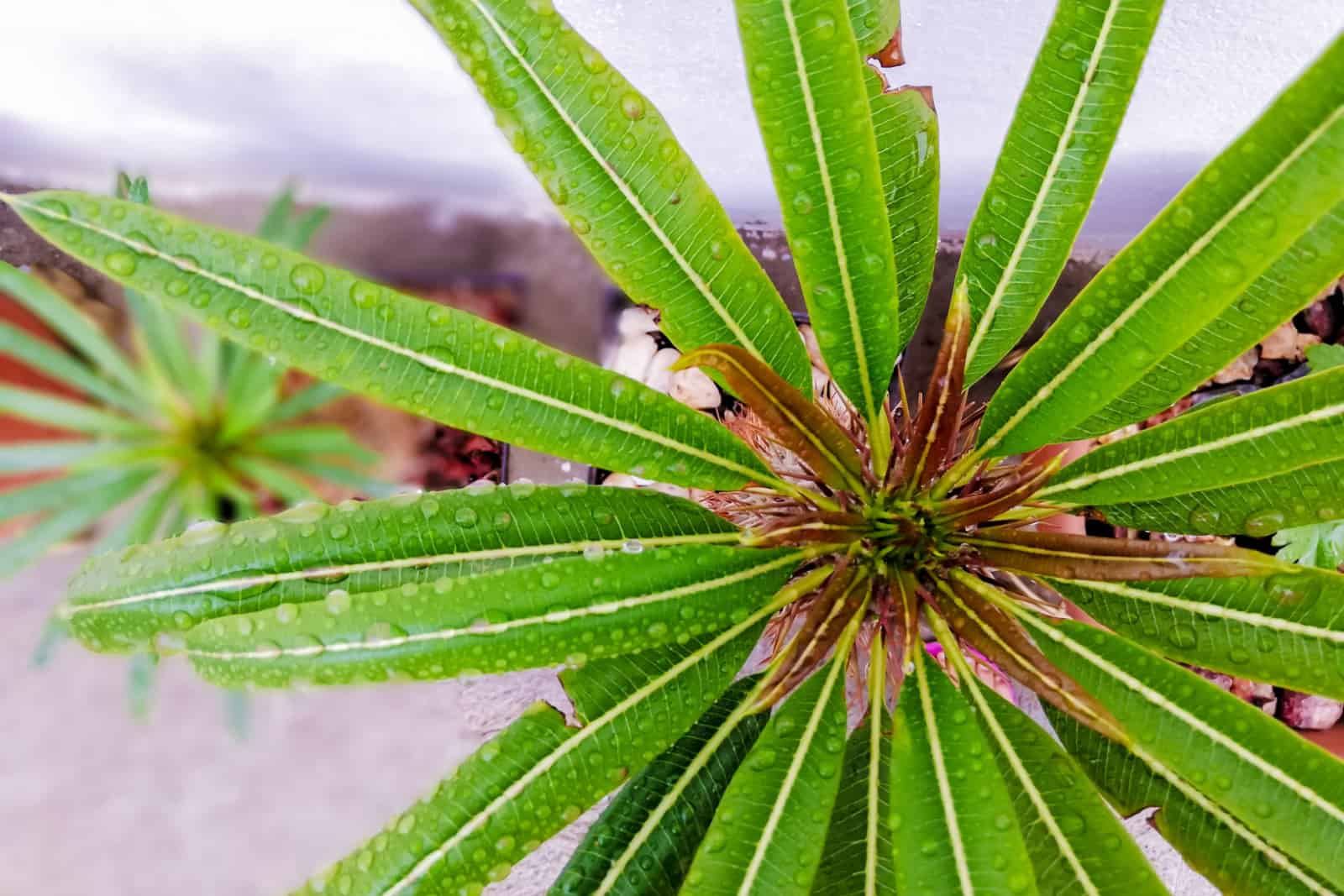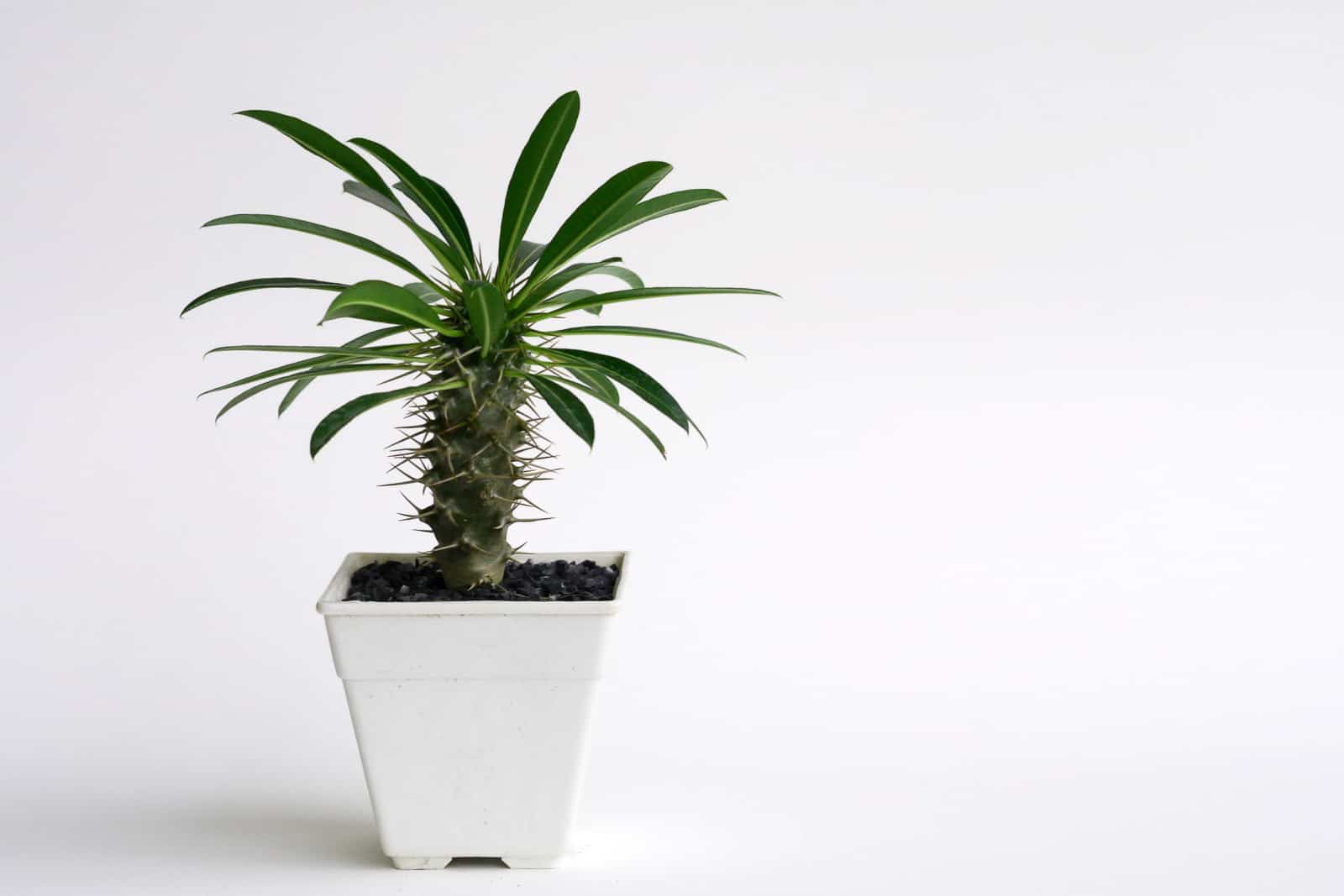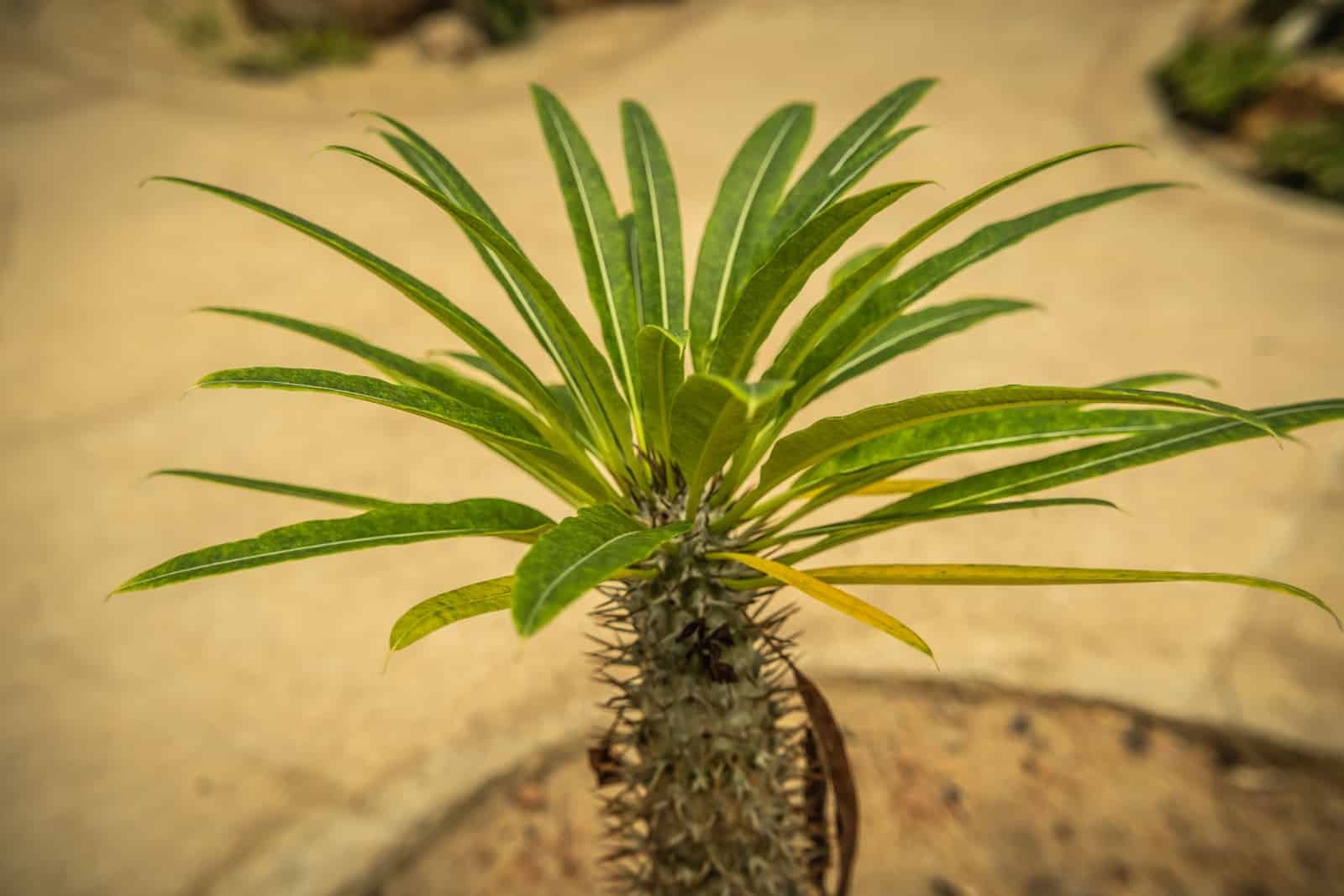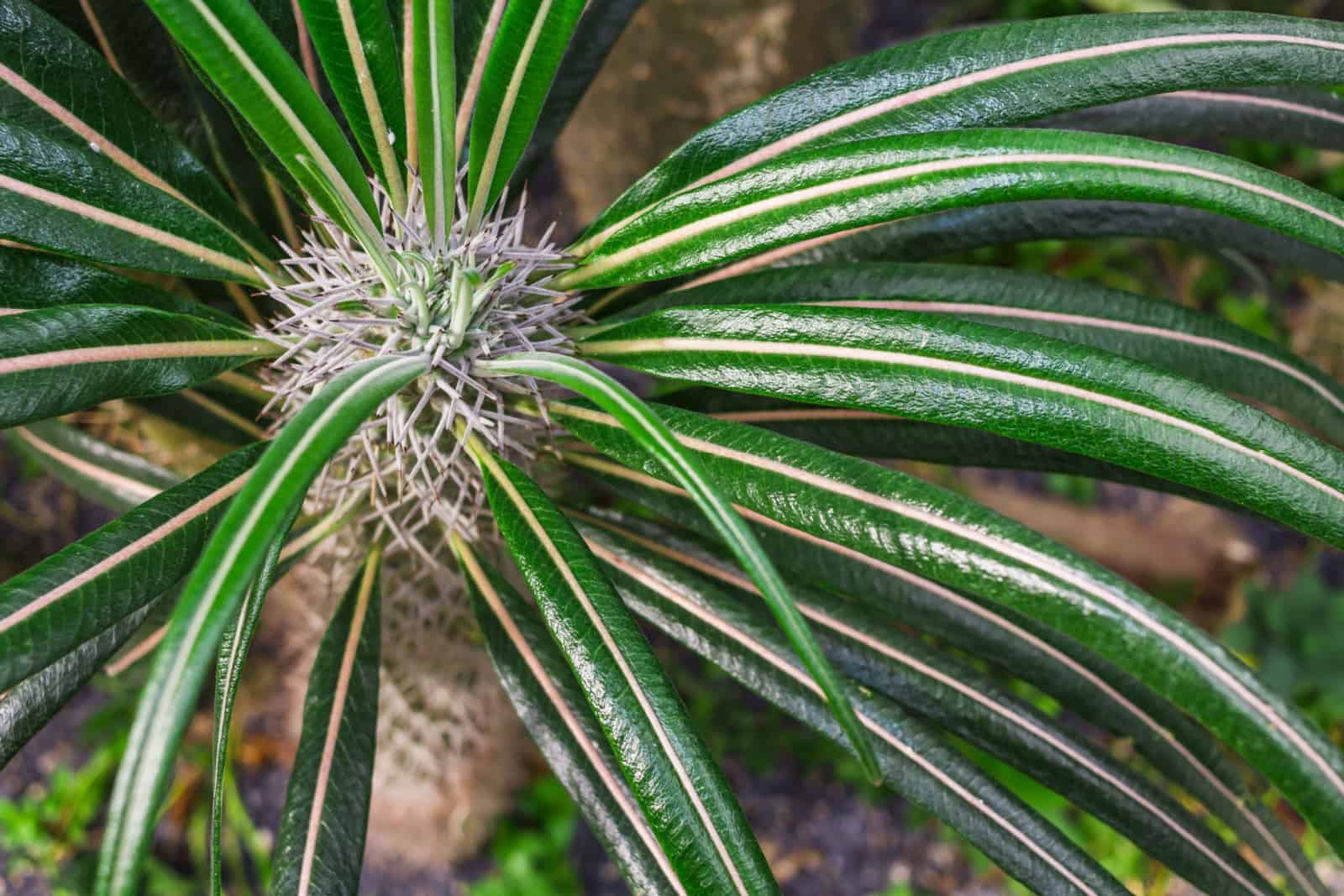Have you ever been to Madagascar? If so, then you are probably already familiar with Madagascar palm trees! But did you know that these palms can also be grown indoors?
If you want to feel like you are on Madagascar island, then you should definitely consider growing this palm in your home or garden. What’s also interesting is that this plant is actually not a palm type at all!
Keep reading to learn more about the fascinating Madagascar palm and how to grow one indoors.
[table id=669 /]
What Is A Madagascar Palm?
When you read the name “Madagascar palm”, you may immediately conclude that we are describing a palm tree. However, that’s not the case with our Madagascan beauty. This plant represents a combination of succulent and cactus – with sharp spines on the trunk’s surface and thick green leathery leaves.
The Madagascar palm, otherwise known as the Pachypodium lamerei, Madagascar cactus palm tree, or Club foot, belongs to the Apocynaceae family.
This plant has a thick, silvery trunk covered with sharp, needle-like spines. It can start branching after flowering, though this happens rarely. However, the trunk does get thicker as the plant grows.
On top of the trunk, there are lovely, long green leaves with white midribs and a leathery texture. This unusual double plant also produces beautiful yellow, pink, or red flowers that smell absolutely amazing!
These flowers usually appear in the winter, though I must tell you that the plant blooms rarely when cultivated indoors.
The Madagascar palm can grow up to 20 feet tall and 6 feet wide in its natural habitat. However, when grown indoors, their growth is restricted and they generally only reach about 4 to 6 feet tall.
Keep the plant away from pets and kids because they can easily get stung and it’s poisonous to humans and animals, so keep that in mind as well.
If you are interested in growing plants in your yard, then check out: The Best North Carolina Palm Trees For Your Backyard
How To Take Care Of A Madagascar Palm
Taking care of this unique plant is relatively easy. Since it is a succulent-like plant, you will have to provide it with succulent-like growing conditions. This plant thrives in USDA hardiness zones 9b to 10.
If you live in a somewhat colder region, I would recommend growing this plant indoors. Keep reading to find out more about its growing requirements.
Soil Requirements
There are various potting soils for palm trees out there!
Since we are not talking about a palm tree per se, the soil requirements vary slightly from regular palm trees. In fact, it is easier to grow a Madagascar palm tree because they are not too picky about the soil type.
They are salt-tolerant, which means that they can grow perfectly fine in coastal landscapes.
These plants thrive in potting soil that drains well, is nutrient-rich, and can hold moisture. They prefer a somewhat damp soil that is not too dry or too soggy, as this might cause root rot. Loam or sandy soil with good drainage is the ideal soil type; if your soil is too compact, like clay, you can add peat moss or sand to loosen it out a bit.
You can also create different soil mixtures by combining sand with peat and bark, or you can mix potting soil with cacti soil and perlite. Growing the plant in cactus compost often leads to good results.
They prefer soil with pH levels between 6.1 to 7.8, so keep that in mind as well!
Light Requirements
The Madagascar palm is used to growing in full sun exposure, which is something that you must provide if you want your plant to grow big and strong!
Like most succulent plants, the Club foot plant can also tolerate growing in partial shade. If you plan to grow it outdoors, make sure to find a sunny location for this plant.
However, if you plant it indoors, the ideal location would be near a west- or south-facing window. Rotate the plant regularly so that all of it receives sunlight.
If you have an empty space near an east-facing window, then consider growing a Cascade palm to get full-on tropical vibes!
Water Requirements
Watering succulents is a relatively easy task. All you have to do is water the plant once the soil has completely dried out. They don’t mind going without water for a little while since they are succulent-like plants, although you shouldn’t leave them without moisture for too long.
However, it is always better to keep the soil dry rather than soggy because soil that’s too wet might lead to root rot. Root rot is a common cause of a dying palm tree, which is why you have to be extra careful!
Growing your Madagascar palm plant in a pot with drainage holes is another great solution to avoid overwatering. The drainage holes can drain excess water quickly so your plant doesn’t sit in soggy soil.
These plants also go dormant during the winter months, which is why you should ease up with watering during this period.
Fertilizer Requirements
Madagascar palm plants are not heavy feeders. Still, they will benefit from some plant food during the growing season. There are various palm fertilizers that you can employ, and I usually use Majesty palm fertilizers, although you can use another type of fertilizer.
For instance, if you are using an all-purpose liquid fertilizer, it is important that you dilute it to half strength. You can start applying an all-purpose one at the beginning of the growing season, or you can apply low nitrogen fertilizer every four to five weeks during the growing season.
This will encourage leaf production and trunk thickening.
Avoid applying fertilizers during the winter months as your plant is not actively growing. Don’t apply too much fertilizer during the growing season either because it may result in chemical build up in the soil.
Always follow the instructions displayed on the packaging.
Humidity Requirements
You won’t have to worry too much about humidity since these plants are used to growing in relatively dry conditions. For them to grow healthily and happily, humidity levels should be above 40%.
This is relatively normal household humidity. However, if you need to boost humidity, you can try and mist your plant on a regular basis (though I don’t recommend this method because it can attract lots of fungi and insects).
The best method is investing in a humidifier – this way, you can set the required humidity levels and simply relax afterwards. You can find them for fair prices on Amazon or Etsy.
You can also create a pebble tray. Simply put some pebbles in a tray, cover them with water, and put your plant on top of it. Water will evaporate and provide moisture for your plant.
Temperature Requirements
You know that they are adapted to warmer climates, which means that you have to provide your African succulent-like plant with the same conditions. Always keep temperatures above 50 degrees Fahrenheit.
These plants are not frost hardy, so they would likely get cold damage if temperatures dropped below 50 degrees. In addition, they don’t like sudden temperature changes, so keep that in mind as well because palm leaves can turn yellow due to temperature fluctuations.
Move your plant indoors if the weather gets cold in your region, and don’t put it near air conditioning, vents, space heaters, radiators, or fire places.
Pruning
Pruning is not a necessary step in the care instructions because you won’t need to do it to encourage your palm plant’s growth and development (unlike many other houseplants that require pruning). A Madagascar palm will grow densely and develop its own distinctive shape, so you won’t have to worry about trimming as much.
However, in order to stop the spread of infection, you should remove any dead or damaged leaves. To get rid of them, use a knife or pair of pruning shears. Keep in mind that you should only use sterilized gardening tools!
Repotting
Due to its slow growth, your Madagascar palm won’t require repotting every growing season. If the roots are coming out of the drainage holes or the plant has stopped growing altogether, then it should be repotted to a larger pot. These plants should be repotted once every three years.
Early spring and summer are the best times to repot these palms because they need enough time during the growing season to grow and adjust to their new homes!
Get a larger pot and check to see if it has drainage holes in the bottom – this is a must. Clay pots are also ideal for these types of plants.
Here are the instructions for repotting:
1. To prepare the soil and prevent transplant shock in the plant, water it the day before repotting. This will loosen up the soil.
2. Repotting should be done the day after watering. Begin by carefully lifting your palm tree; take care not to damage any of the roots that are poking out of the drainage holes.
3. The next thing that you should do is gently remove the old soil! Since the roots are so delicate, damaging them could cause your plant to go into shock.
4. Plant your Madagascar palm in the new container. Fill the pot halfway up with a proper potting soil, then add more soil on top of the root ball.
Propagation
There are two ways to propagate this palm plant – by growing it from seeds or by using side shoots from the main plant. They will usually produce side shoots that eventually turn into a new plant.
I wouldn’t recommend growing from seeds because you have to wait for too long to see your plant grow and sprout. If this is something you enjoy, however, then go for it by all means!
This is how you propagate a Madagascar palm from side shoots:
1. Just as with repotting, water your plant the day before propagation.
2. After that, look at the plant to see if there are any side shoots. Cut the biggest shoot using a clean knife. Leave your new plant in the sun and let it form a callus.
3. You should then pot your new plant. The soil in your new pot should be well-draining. Add enough soil to properly cover the base of the plant.
4. Put it in a location with sunlight and water it moderately. Keep up with regular plant care and your baby Club Foot will grow and thrive!
For more information about propagating the Madagascar palm, you can check out this video:
Issues With The Madagascar Palm
Even though this plant is poisonous and has sharp thorns all over its surface, there are still some pesky pests and insects that invade it – trust me, these little bugs are not easily scared!
If you take good care of your plants, you lower the chances of them getting pest infestations and plant diseases.
Let’s take a closer look at the common issues with the Madagascar palm.
Pest Infestation
This lovely plant is susceptible to pests such as aphids, scales, and mealybugs. If you examine the leaves and find any stains or discoloration, you may have an infestation of these three obnoxious little animals that steal the nutrients from your plant.
Aphids are tiny white insects that can be barely spotted with the naked eye. They are sap-sucking insects that are usually seen on those long green leaves. Sometimes they hide on the undersides as well. You can use insecticidal soap, neem oil, or soapy water to get rid of them.
Mealybugs are one of the most difficult pest issues for plants to deal with since they multiply quickly. They can seriously damage your plant, especially if it’s young!
To get rid of mealybugs, use rubbing alcohol or neem oil.
If you notice anything sticky on your plant, scales are definitely to blame since they generate sticky honeydew. By wiping the leaves with a towel soaked in rubbing alcohol, you can easily remove scales.
Plant Disease
As we’ve already discussed, overwatering this plant causes the leaves to change color. Nevertheless, excessive water can also lead to other problems that are considerably more significant than leaf color change, such as increased susceptibility to fungal infections.
Overwatering can lead to the severe plant disease known as root rot. The palm likely has root rot if the plant’s leaves start to show spots and the soil begins to smell strange, especially if you started watering it more frequently.
Take the plant out of the pot as soon as you discover any of these signs, then promptly check the roots; if you see any that are damaged, cut them off and adjust your soil’s pH.
Repot the plant in new soil and a new pot, and also apply fungicide.
To Sum Up
If you are really into tropical aesthetics, then you should definitely get yourself a Madagascar palm. This unique plant is an interesting conversation piece – I mean, how often do you see two plants combined in one?!
It looks like a palm, but it has succulent-like requirements, so it’s a win-win situation!
Propagating the Madagascar palm is also quite easy, though you have to be careful not to damage the mother plant when cutting the side shoots. You also won’t have to worry about regular pruning or repotting.
If you tend to forget about watering your plants regularly, you won’t have to worry about that either since these plants can tolerate some drought.
That’s all, folks. I hope this article was helpful.
Until next time!

